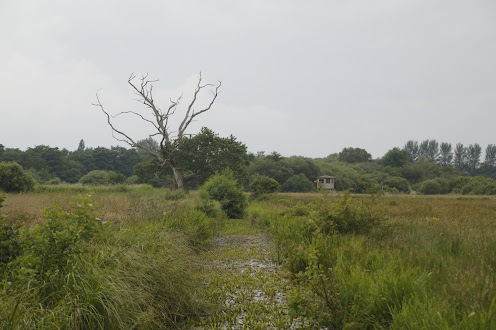The premier reserve of the Suffolk Wildlife Trust, Carlton Marshes, is a large chunk of wetland on the border of Lowestoft, within the Norfolk Broads. Most of the reserve is brand new, a huge purchase of land, that was achieved following a large appeal. From what was, before the purchase, degraded farmland is now a bustling wetland full of birds. This is a testament to imagination and foresight, to see something remarkable in what was unremarkable.
A big statement for the reserve is the huge new visitors centre, a brand new embellishment for a brand new reserve. One of the joys of visiting nature reserve cafes is the comparison between the different cakes they sell, more specifically the scones. Minsmere has great scones, other reserves not so. Carlton Marshes unfortunately has no scones, although it had some nice cake slices. But where else can you enjoy MARSH HARRIERS flying in the distance whilst enjoying a coffee. From the centre the reserve opened up before me, stretching to the horizon in this flat land, a sea of grass, moorland perhaps, but something wild, a new land that somehow feels timeless, like something dating back to prehistory.
This was my first visit to the reserve since the pandemic, and it had changed quite a lot. The new reserve is huge, stretching from horizon to horizon. Since the time I last visited the Trust has had the chance to modify the land. The southern section round Share Marsh is more overgrown with reeds, alongside which grazing has created a good range of habitats. Wet flashes predominate in this area, each one seeming to harbour a MUTE SWAN family. From the Lookout Hide, I found a SHOVELLER brood of three on one of these flashes, a bird that despite being a common winter visitor to our country, is a fairly rare breeding bird, and a testament to the work done by the Trust.
A common sight on the reserve was the CHINESE WATER DEER, an introduced animal that has found its own niche in this country, inhabiting the marshes of East Anglia. They are smallish deer that don't have antlers, what they have instead are these long canines, like the fangs of a dog. Originating from China, they escaped from deer menageries, and the UK's Population may be of some importance as their population declines in their homeland. They are quite easy to spot, running around the areas of grassland, and don't seem to be too bothered about humans.
The centrepice to the reserve is Peto's Marsh, which is a combination of wet grassland, and the home of an embryonic reedbed. Scrapes have been dug into the land to attract water birds, shallow bodies of water, that are just as attractive to us birdwatchers, allowing me to set up the telescope to observe the birdlife. There are two hides, but because everything can be viewed from the river wall, they are really shelters for bad weather. Annoyingly this area of the reserve is the furthest point from the car park, so expect a long walk if visiting.
The first scrape, overlooked by Turnpike Hide, was the best for WADERS, an area of water in some grazed grasslands. Star bird was a WOOD SANDPIPER, an uncommon Autumn migrant (yes with some birds we are really are in Autumn) to places like this. Further Autumn migrants were present with three GREEN SANDPIPERS, stalking the muddy areas, in and out of the tuffs of sedges. Breeding waders were very much in evidence with large numbers of young REDSHANK present, all of various ages and different sizes and plumages. You don't often see young redshanks, the parents usually keep them in the longer grass to escape from the eyes of crows and harriers. Young Avocet were also present, mostly grown now, but with shades of brown in places. This evidence shows this area is good for breeding birds, already so early in its life. For waders to breed they need water, which by new management the Trust has added to the land, creating new habitat in what was unproductive farmland. Newly created wetlands are often full of birds, as at the beginning as the newly flooded area is fertile and rich in insect life, enticing them to settle. It will take a few years before things stabilise, but the area should stay attractive to birds.
A walk further along the river wall led to North Hide which overlooked a scrape within the newly created reedbed. On this piece of water was the ends of a GULL colony, having by this time nested and raised young, they were now on the verge of leaving, and an EGYPTIAN GOOSE was also present. Further along the wall, before the path ended at a gate, was another scrape, in which four GREAT WHITE EGRET were present, often in the same binocular view as its smaller cousin the LITTLE EGRET. Later on whilst walking back to the visitor centre, I had a nice view of a LITTLE RINGED PLOVER in flight, another Autumn migrant wader, which rounded off a good day of birding.







No comments:
Post a Comment